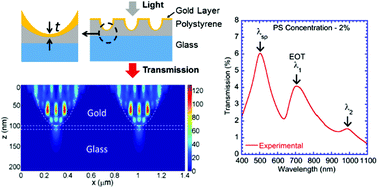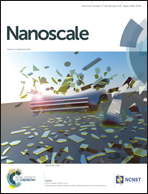Extraordinary optical transmission in nanopatterned ultrathin metal films without holes†
Abstract
We experimentally and theoretically demonstrate that a continuous gold film on a periodically textured substrate exhibits extraordinary optical transmission, even though no holes were etched in the film. Our film synthesis started by nanoimprinting a periodic array of nanocups with a period of ∼750 nm on a polystyrene film over a glass substrate. A thin non-conformal gold film was sputter-deposited on the polystyrene by angle-directed deposition. The gold film was continuous with spatial thickness variation, the film being thinnest at the bottom of the nanocup. Measurements revealed an extraordinary transmission peak at a wavelength just smaller than the period, with an enhancement of ∼2.5 compared to the classically expected value. Scattering matrix simulations model well the transmission and reflectance measurements when an ultrathin gold layer (∼5 nm), smaller than the skin depth is retained at the bottom of the nanocups. Electric field intensities are enhanced by >100 within the nanocup, and ∼40 in the ultrathin gold layer causing transmission through it. We show a wavelength red-shift of ∼30 nm in the extraordinary transmission peak when the nanocups are coated with a thin film of a few nanometers, which can be utilized for biosensing. The continuous corrugated metal films are far simpler structures to observe extraordinary transmission, circumventing the difficult process of etching the metal film. Such continuous metal films with ultrathin regions are simple platforms for non-linear optics, plasmonics, and biological and chemical sensing.


 Please wait while we load your content...
Please wait while we load your content...